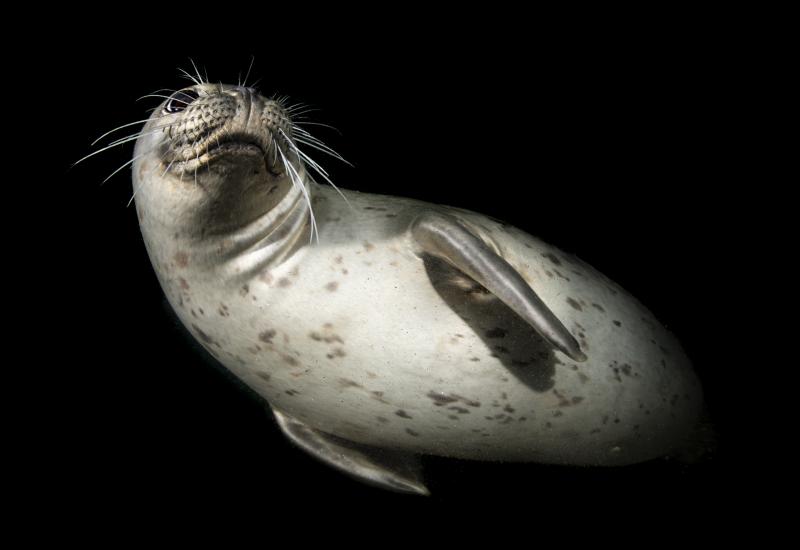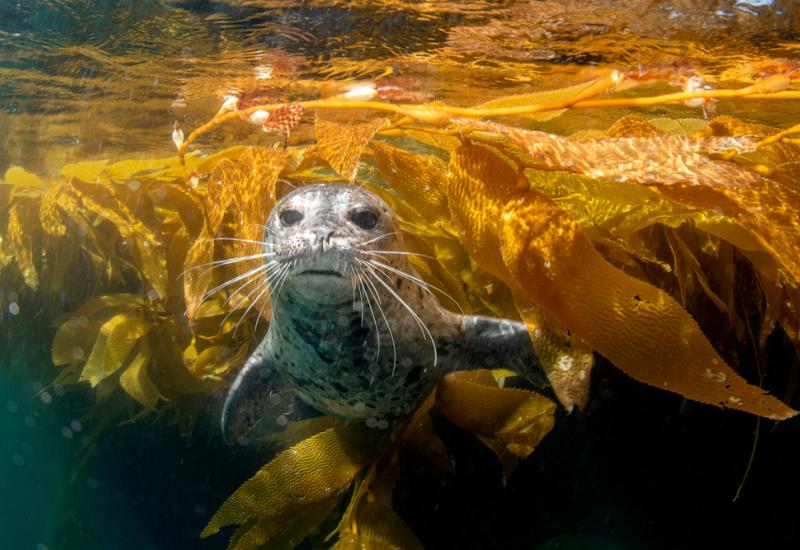How to Dive From Your Own Boat on California’s Monterey Peninsula
Scuba divers in central California are fortunate to have great diving at their doorstep. More than 50 dive sites in the Monterey and Carmel areas cater to divers of all skill levels and offer diverse profiles and abundant marine life. Though many sites are accessible from shore, some spots do require a boat. Joining an organized charter is an obvious, easy option, while those who prefer DIY can also take helm of their own boat. It need not be a glitzy, multimillion-dollar yacht. The Monterey Peninsula is an ideal place to play master and commander in much more modest vessels.
CHOOSE YOUR SEA CHARIOT
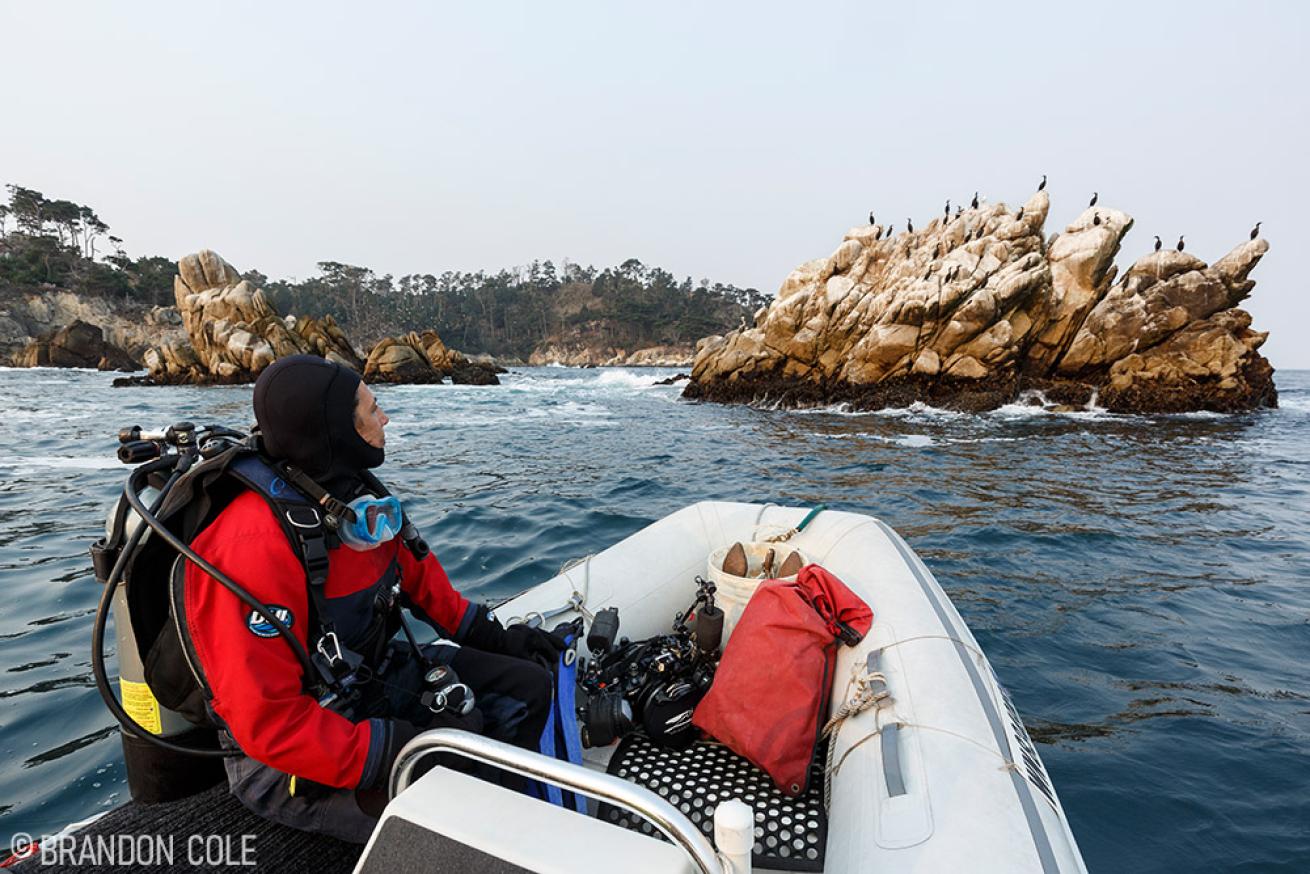
Brandon ColeA drysuit diver prepares to explore rocky reefs and pinnacles in protected waters at Point Lobos State Natural Reserve.
Zodiac-style inflatable boats and dive ‘yaks— stable, sit-on-top kayaks— are both practical, effective ways to dive the reefs, pinnacles, and kelp beds along this superlative stretch of coastline. An inflatable, powered by an outboard motor, costs more than a human-powered kayak and requires additional maintenance but accommodates more passengers and gear and excels in accessing distant sites. Inflatable boats between 12 and 18 feet long are commonly used in Monterey and Carmel Bays. A handful of popular brands are Zodiac, Polaris, and Achilles.
Budget-friendly and launchable almost anywhere, single and tandem sit-on-top plastic kayaks between 11 and 15 feet long are a great alternative. Models manufactured by Ocean Kayak, Malibu Kayaks, and Cobra Kayaks are favored by many divers. When researching specific models, solicit input from experienced kayak divers and make certain your ‘yak of choice has enough cargo space and a total weight capacity that’s sufficient for you and your dive equipment. Not all designs are appropriate for scuba pursuits, especially for people bringing along an extra tank and/or a big camera rig.
PERKS TO BEING CAPTAIN
Diving from your own boat affords ultimate freedom to dive when, where, and how you want. Care to splash mid-week to avoid the crowds or take advantage of soon-to-be-gone amazing sea conditions with killer visibility and zero swell? That’s easily accomplished in your own craft, but unlikely with charter operators who typically schedule weekend-only outings. Keen to thoroughly explore the same spot three times in a row without having to take a vote in a group? Have a special photo or video project requiring extra-long bottom times which would inconvenience or be impossible for others? Want to ensure that your buddy or buddies are on the same page as you in terms of experience level and focus? Check, check, and check! Being master and commander gives you flexibility and control. This is harder to come by on an open boat charter full of people with potentially widely varying diving styles, goals, and levels of training.
Speaking personally, I’ve found that I’m usually more productive (and less stressed) in my underwater photography work on the Monterey Peninsula when I am calling the shots in my own boat. But of course, this pathway is not for everyone. Boat trailers and oil changes, licensing and roof racks add considerably to a diver’s gear pile and to-do list. Owning and maintaining a dive boat equates to more work, greater storage space, and additional expenses. From a cost per dive perspective, however, having your own boat may actually save money in the long run if you do a lot of boat diving. That $150 (on average) per day spent on local charters adds up quickly.
DIVE SITE SAMPLER
Here are some sites I enjoyed diving from my 15-foot-long, rigid hull inflatable boat (RIB for short) on my last trip to the Monterey and Carmel area.
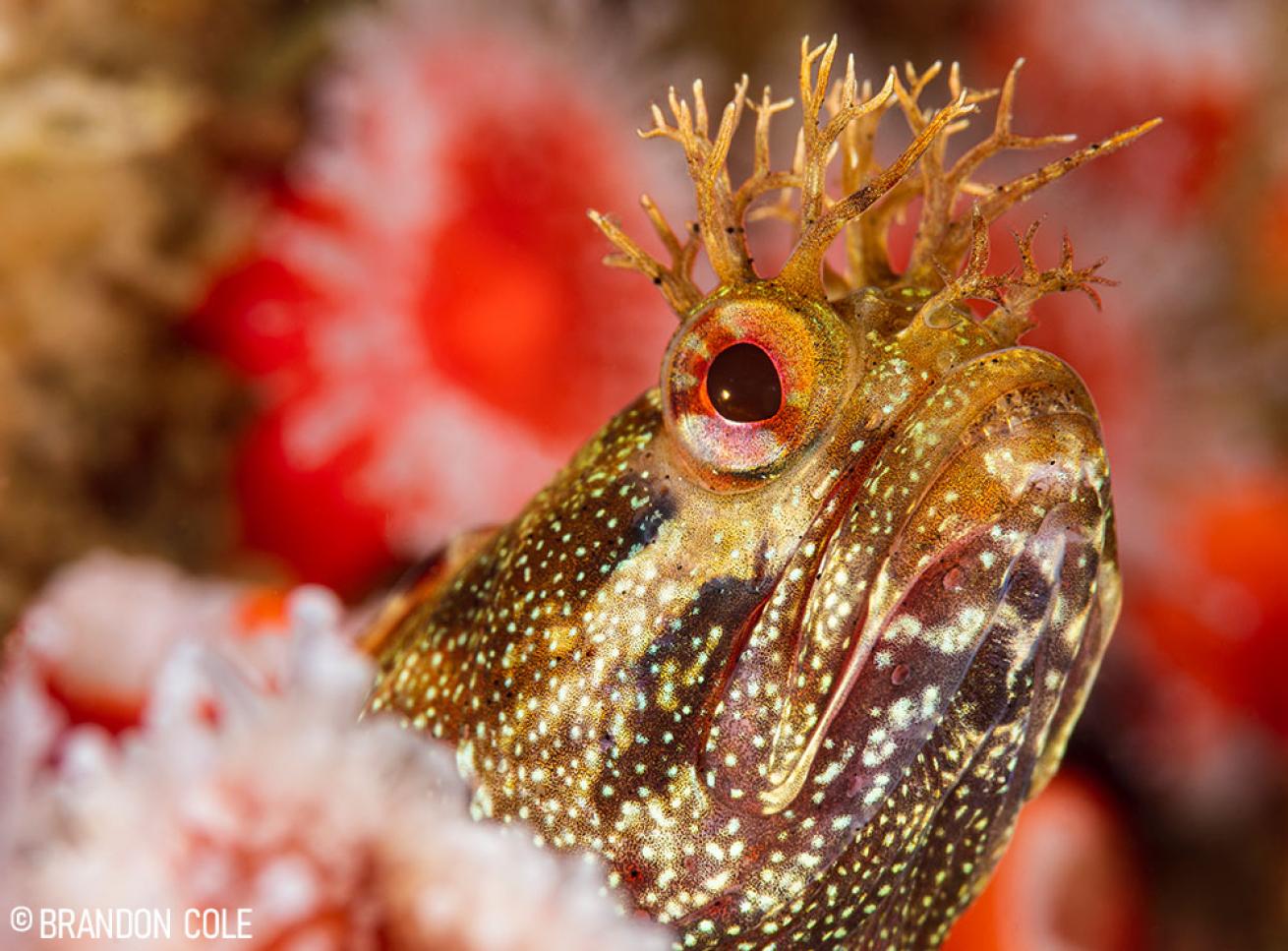
Brandon ColeThe yellowfin fringehead blenny can grow up to four inches long with three multi-branched cirri on top of head.
Tanker Reef (Monterey Bay)
Located approximately one-half mile off Del Monte Beach, this is a rock plateau a few feet above the flat muddy bottom in 55 to 60 feet of water that makes a fun macro photo dive. As the only significant solid substrate around, this is a magnet for marine life of the smaller variety. The edge of ledge is covered in strawberry anemones. Look closely to spot yellowfin fringehead blennies, ronquils, juvenile treefish and other rockfish, moss crabs camouflaged in sponges, nudibranchs, and octopus. Tanker Reef, also called Shale Beds, is easily reached by launching your boat at either the Coast Guard Pier at the Breakwater (aka San Carlos Beach), or the ramp in Monterey’s main harbor between Fisherman’s Wharf and Municipal Wharf II, right next to K dock where the commercial dive charters pick up passengers. Both public ramps are free to use, though vehicle (and trailer) parking is not! Kayaks can be launched straight off Del Monte Beach. GPS greatly aids in finding Tanker Reef quickly. I used the following coordinates: 36° 36.531’ N, 121° 52.786’ W.
Outer Point Pinos (Monterey Bay)
It’s possible to shore dive the shallower reefs off exposed Point Pinos, but only on the calmest of days. Even then it can be a rough and exhausting ordeal. A boat is your ticket to explore the best of the dramatic subsea landscape— huge boulders, twisting channels and an enchanting kelp forest— at this southwestern-most corner of vast Monterey Bay. I prefer the outer perimeter of the kelp beds in 50 to 90 feet of water, rarely dived happy hunting grounds for critter watchers like me. On back-to-back submersions last September, I spied black and yellow rockfish reclining on rugged real estate covered in bryozoans, coralline algae and barnacles. There were clusters of feather duster worms resembling festive pompoms, and sweet sea slugs including Cockerell’s dorid and Hilton’s aeolid. Amongst the golden kelp plants were perch, giant kelpfish, and purple-ringed topsnails.
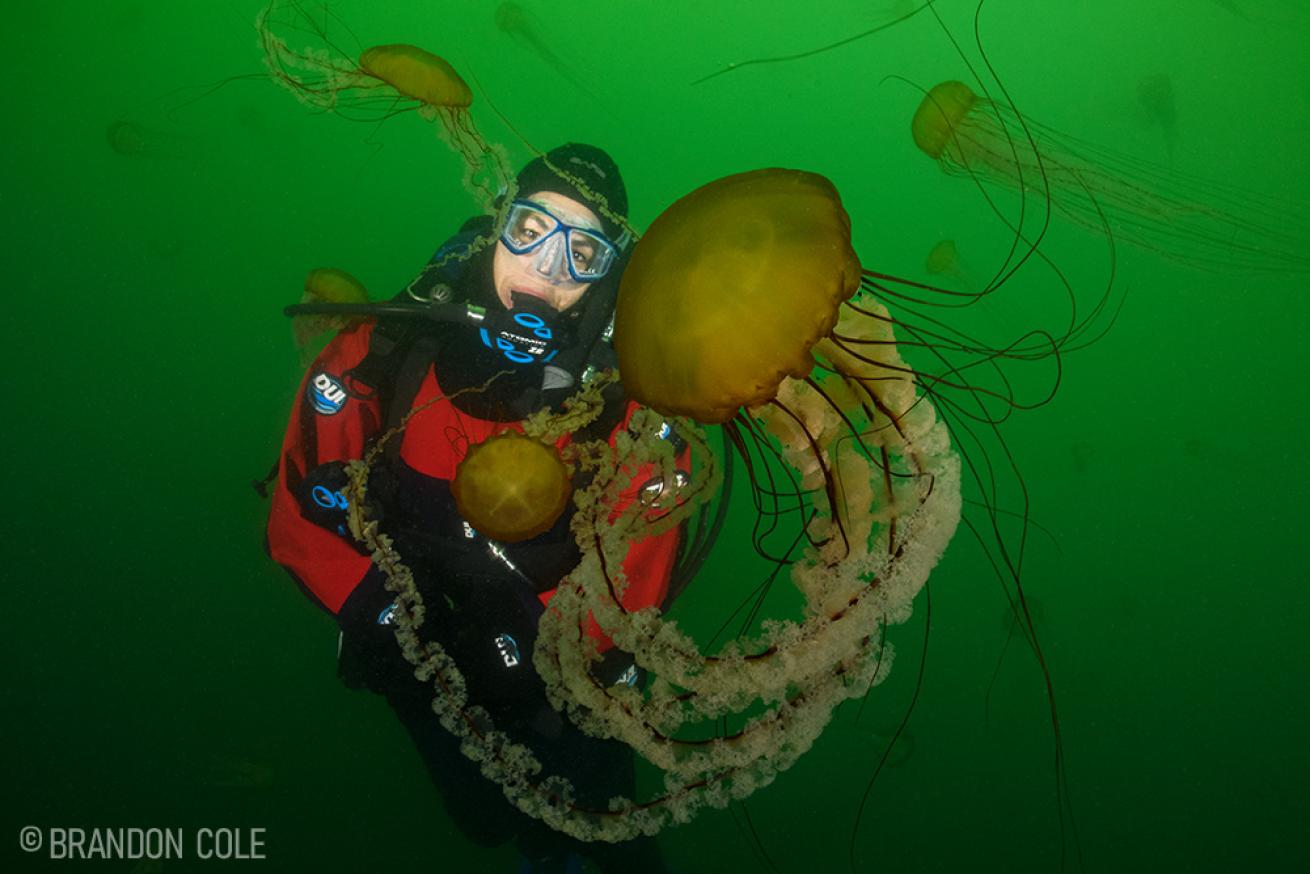
Brandon ColeScuba diver admires a Pacific Sea nettle jellyfish.
Metridium Mountain (Monterey Bay)
More protected from wind and big swell and offering a completely different look to the Bay, this site off Hopkins Marine Station showcases plumose sea anemones, Metridium farcimen. Rock promontories rising five to 15 feet above the sandy bottom 65 feet deep are decorated with the large cauliflower-like white invertebrates that glow with an eerie beauty in the green plankton-rich waters. Fish-eating anemones, knobby sea stars, and bat stars also live here, along with a variety of fish species. During summer and autumn, waves of sea nettle jellyfish drift into Monterey Bay, often passing right overtop this easy-to-dive site. Using a depth sounder and visual landmarks on shore can help you find this boat access-only site, or you can zero right in with military precision targeting 36° 37.327’ N, 121° 53.982’ W with your GPS.
Brandon’s Bluefish Cove Pinnacles (Point Lobos State Natural Reserve in Carmel Bay)
As much as I love Monterey Bay, whenever the swell is down I head down to Carmel Bay — home to most of my favorite dives on the Monterey Peninsula. Having one’s own vessel is hugely advantageous here. Point Lobos boasts a number of excellent dives, with the cream of the crop only reachable by boat (or using a mountain of tec gear- multiple tanks, scooter, rebreather, etc.). Put your kayak or small boat into the water at the boat ramp to access Bluefish Cove’s many sites. Some are known and named. Others await discovery, like the steep rocky slope with adjacent granite spires I found while toddling around wondering what awaited below. Being master and commander encourages exploration! My reconnaissance jump just outside a randomly chosen patch of kelp blew me away. Craggy crevices in the plunging rock wall between 60 and 100 feet deep were filled with colorful tangles of brittle stars, stunning purple hydrocorals, chestnut cowries, and curious gopher and vermilion rockfish. My first tank only scratched the surface of what this place promised, so a second splash followed to further document the denizens of “my” secret reef. Note that one cannot dive within Point Lobos’s boundaries by entering from outside the reserve. Divers are required to register at Point Lobos, pay the appropriate fees, and enter the water via the ramp, whether shore diving or boat diving.
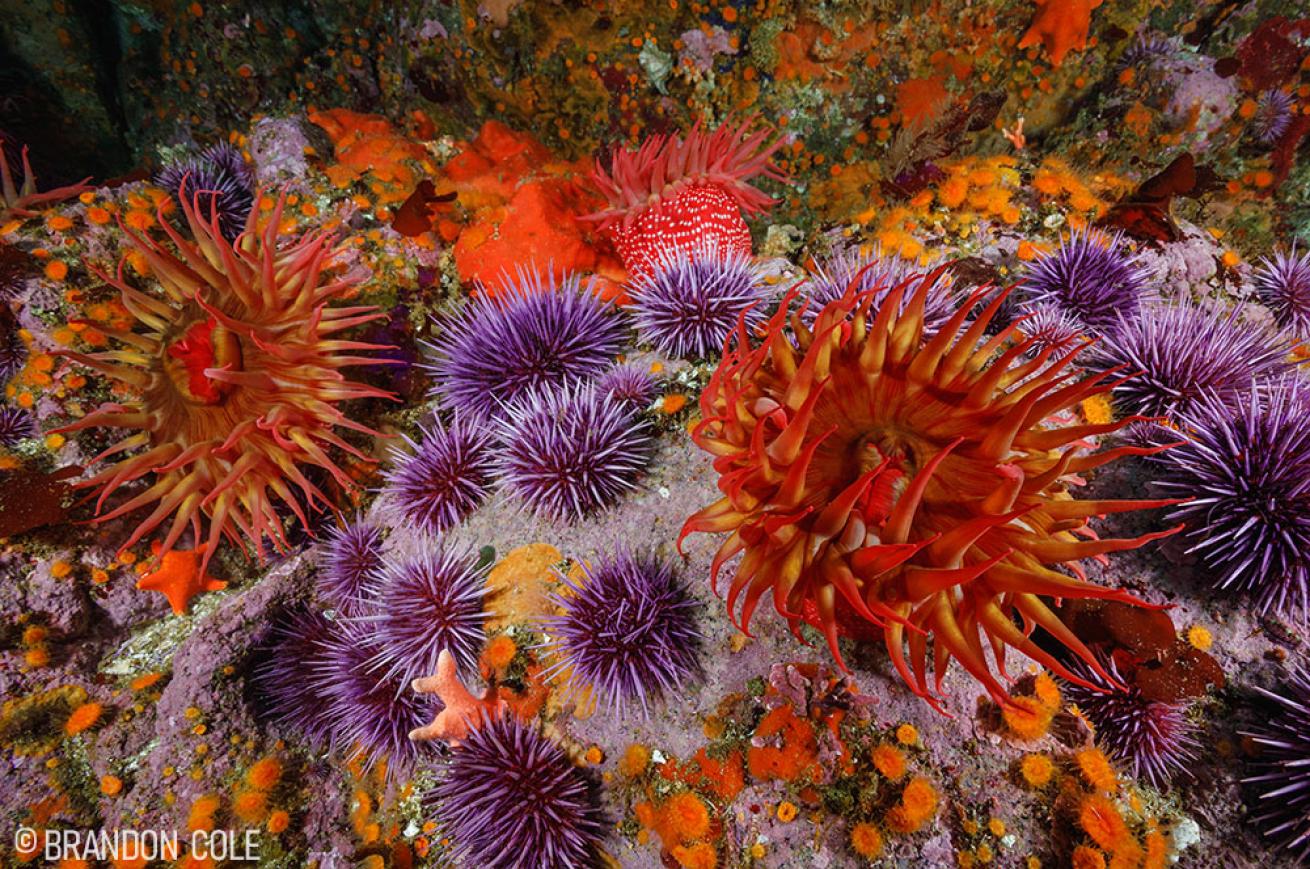
Brandon ColeColorful rocky reef with spotted rose sea anemones and purple sea urchins.
Inner Pinnacles (Carmel Bay)
A collection of seamounts in northern Carmel Bay has long lured experienced divers. About three-quarters of a mile offshore posh Pebble Beach, the Pinnacles are exposed to mighty swells (translating into mighty surge beneath the waves) and strong winds, and therefore should only be attempted on days with very favorable conditions. A thick forest of bull kelp and giant kelp grows atop breathtaking underwater reef architecture. Amongst soaring granite monoliths are narrow gorges, box canyons, stair-stepping mini-walls and serrated ridges. Hydrocorals galore in orange, pink, and purple cling to the rock faces, along with bright sponges and tunicates, sea urchins and cup corals, and carpets of rose spotted anemones. Ling cod, cabezon, greenling, and gobies are abundant. Schools of blue rockfish hover under the kelp canopy. Occasionally, harbor seals and sea lions even pay divers a visit. Depths range from 15 feet to 100. For those who have logged enough time at the helm of their boat and are prepared to travel greater distances— it's a 10-mile run from the public boat ramps in Monterey Bay or three miles from Point Lobos— Inner Pinnacles deserves inclusion on the “must dive list.”
DIY BOATING STANDARD OPERATING PROCEDURES, TIPS AND TRICKS
Over many years of diving from small boats I’ve picked up tips and tricks from salty sea dogs generous with their lore. I’ve also developed some of my own standard operating procedures (SOPs). Here is information— some general, some specific to the Monterey Peninsula region— which may prove useful to others embarking on their own adventure.
Boat bits and bobs:
• Brass clips on short lines tethered to your boat are great for hanging over weight belt, BCD/tank/reg, camera, etc. when getting out of the boat into the
water, and vice versa.
• Dry bags to help keep important things dry
• Straps, mesh bags, and cargo nets to help secure all gear in the boat. Especially important for kayak divers, in case waves wash over the top or in a
capsizing event. Don’t forget to secure your paddle, and keep your BCD setup fully inflated during transit just in case!
• Anchor, chain, line (rope). Make sure your anchoring equipment is appropriate for your boat and where you will be diving. The line must be long enough—
250 to 300 feet is a good starting point. Mark your anchor line so you can easily gauge how much line you’ve let out. Take extra lines just in case you need
to be towed, or tie off to kelp, tie to another boat, and so on.
• Marine charts and a depth sounder can be very handy.
• GPS device- indispensable in finding submerged reefs and for general navigation
• Extra fuel and fuel line for motorized vessels
Safety gear:
• EPIRB or personal locator beacon, mandatory in my opinion.
• Cell phone, for a million reasons
• VHF radio, handy for boat to boat (and harbor) communications, as well as mayday calls and weather reports
• Dive flag to warn other boaters that you are in the water
• Life vests, aka PFDs (personal flotation devices)
• First aid kit, water, and food
• Vessel Assist / Towing insurance
Protocols and miscellaneous:
WEATHER
Double-check weather forecasts shortly before you launch, and periodically while out on the water to make sure bad weather isn’t quickly on its way. Be wary of thick fog materializing suddenly; if you cannot wait for it clear, proceed slowly and carefully, using your GPS to navigate. Shut down periodically to listen for other boats. Reviewing swell forecasts ahead of time can help you decide where to most comfortably dive that day. When the swell is large (say six feet or more), especially if it’s coming from the west or southwest, remaining inside Monterey Bay and diving close to shore along its southern rim is advised to avoid strong surge underwater. Generally speaking, Carmel Bay offers less protection.
DIVE PLAN
Leave your dive plan with someone on land, informing them of your intended destination(s) that day, when you expect to be back onshore, how many people are in your group, your cell phone number, and a basic description of your boat(s). Check-in with your contact when you are back onshore.
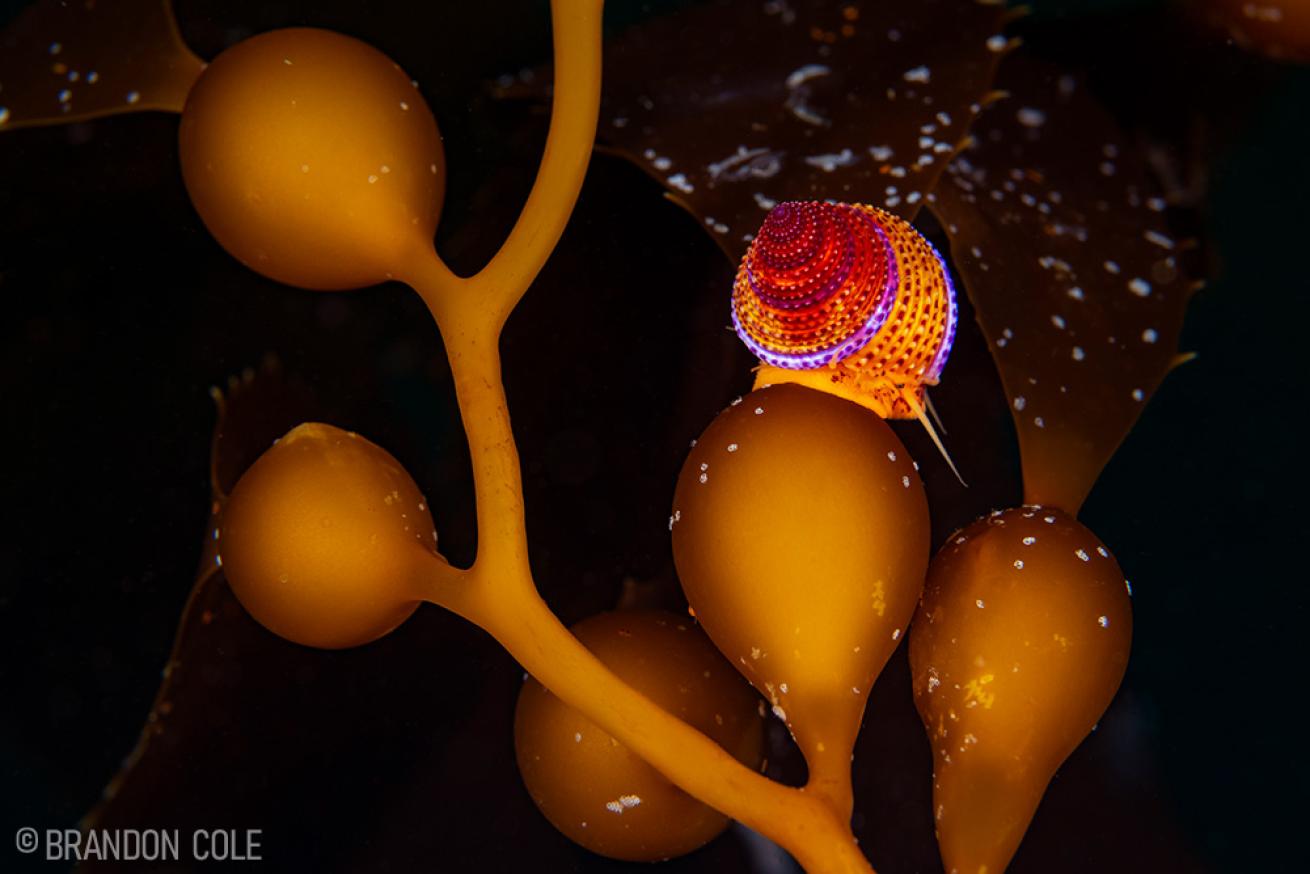
Brandon ColePurple-ringed topsnail on giant kelp. This colorful shell grows to four centimeters wide and primarily eats hydroids.
ANCHORING
Make sure you leave enough slack (“scope”) when you let out and tie off your anchor line. A ratio of at least 3:1 (and up to 7:1) line length to water depth is often recommended, though the type of boat, conditions, and dive site location should also be taken into consideration. If possible, tie off a second line to nearby strands of kelp on the surface (as long as that kelp is attached to the bottom!) as a backup just in case your anchor falls off a high spot during the dive and ends up dangling free in deep water— which would set your boat adrift. When you begin your dive, check the placement and hold of your anchor, and move the anchor (or redeploy entirely) if necessary. Be mindful not to harm marine life. Using your compass to navigate during the dive can help you return to the anchor at the end of the dive.
MAINTENANCE
Take care of your boat with regular maintenance and inspections performed by those who know what they are doing. Your life may depend on this. Confidence in your sea chariot will provide peace of mind and make your diving much more enjoyable.
BOAT LAUNCHING
Personally, I prefer the public ramp inside Monterey’s main harbor for launching my inflatable, zodiac-type boats from trailers. It is completely protected from swell, well maintained, and it’s easy to launch and retrieve boats regardless of tide height. It can be busy on weekends. The Coast Guard launch at the Breakwater is good but may have a bit of surge or crosswind on windy days, making self-launching a bit more challenging here. Of course, it is always easier to have another person on the ramp and/or dock to help with the whole launch/retrieve process while you are operating your automobile. The ramp at Point Lobos is my least favorite of the launches. With a very small boat (say less than 15 feet long) on a long-tongued trailer, using a four-wheel-drive vehicle with good tires, at high tide, on a calm day without swell or crosswind, it is acceptable… but you still need to be very careful about the rocks on either side of the ramp, as well as slippery algae and holes in the concrete. Also, there is no jetty or dock or place to tie off while you drive away to park your auto. Plus, the parking lot at Point Lobos is tight for maneuvering. Launching kayaks is much easier at Point Lobos.

